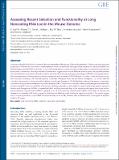Files in this item
Assessing recent selection and functionality at long noncoding RNA loci in the mouse genome
Item metadata
| dc.contributor.author | Wiberg, Ralf Axel Wilhelm | |
| dc.contributor.author | Halligan, Daniel L. | |
| dc.contributor.author | Ness, Rob W. | |
| dc.contributor.author | Necsulea, Anamaria | |
| dc.contributor.author | Kaessmann, Henrik | |
| dc.contributor.author | Keightley, Peter D. | |
| dc.date.accessioned | 2015-09-25T09:10:09Z | |
| dc.date.available | 2015-09-25T09:10:09Z | |
| dc.date.issued | 2015-08 | |
| dc.identifier | 219298488 | |
| dc.identifier | 0bb1d665-5b3e-4e37-81a9-560b97d4dffe | |
| dc.identifier | 84954328295 | |
| dc.identifier | 000360819300027 | |
| dc.identifier.citation | Wiberg , R A W , Halligan , D L , Ness , R W , Necsulea , A , Kaessmann , H & Keightley , P D 2015 , ' Assessing recent selection and functionality at long noncoding RNA loci in the mouse genome ' , Genome Biology and Evolution , vol. 7 , no. 8 , pp. 2432-2444 . https://doi.org/10.1093/gbe/evv155 | en |
| dc.identifier.issn | 1759-6653 | |
| dc.identifier.other | Bibtex: urn:bba3fba1cfe78f05d3688abd9d323c30 | |
| dc.identifier.uri | https://hdl.handle.net/10023/7540 | |
| dc.description | This work was supported by the Biotechnology and Biological Sciences Research Council and The Wellcome Trust. A.N. was supported by the Swiss National Science Foundation (Grant: PZ00P3_142636). H.K. was supported by the European Research Council Starting (Grant: 242597, SexGenTransEvolution) and the Swiss National Science Foundation (Grants: 130287 and 146474). | en |
| dc.description.abstract | Long noncoding RNAs (lncRNAs) are one of the most intensively studied groups of noncoding elements. Debate continues over what proportion of lncRNAs are functional or merely represent transcriptional noise. Although characterization of individual lncRNAs has identified approximately 200 functional loci across the Eukarya, general surveys have found only modest or no evidence of long-term evolutionary conservation. Although this lack of conservation suggests that most lncRNAs are nonfunctional, the possibility remains that some represent recent evolutionary innovations. We examine recent selection pressures acting on lncRNAs in mouse populations. We compare patterns of within-species nucleotide variation at approximately 10,000 lncRNA loci in a cohort of the wild house mouse, Mus musculus castaneus, with between-species nucleotide divergence from the rat (Rattus norvegicus). Loci under selective constraint are expected to show reduced nucleotide diversity and divergence. We find limited evidence of sequence conservation compared with putatively neutrally evolving ancestral repeats (ARs). Comparisons of sequence diversity and divergence between ARs, protein-coding (PC) exons and lncRNAs, and the associated flanking regions, show weak, but significantly lower levels of sequence diversity and divergence at lncRNAs compared with ARs. lncRNAs conserved deep in the vertebrate phylogeny show lower within-species sequence diversity than lncRNAs in general. A set of 74 functionally characterized lncRNAs show levels of diversity and divergence comparable to PC exons, suggesting that these lncRNAs are under substantial selective constraints. Our results suggest that, in mouse populations, most lncRNA loci evolve at rates similar to ARs, whereas older lncRNAs tend to show signals of selection similar to PC genes. | |
| dc.format.extent | 13 | |
| dc.format.extent | 582330 | |
| dc.language.iso | eng | |
| dc.relation.ispartof | Genome Biology and Evolution | en |
| dc.subject | Long noncoding RNAs | en |
| dc.subject | Selection | en |
| dc.subject | Genomics | en |
| dc.subject | Functionality | en |
| dc.subject | QH301 Biology | en |
| dc.subject | QH426 Genetics | en |
| dc.subject.lcc | QH301 | en |
| dc.subject.lcc | QH426 | en |
| dc.title | Assessing recent selection and functionality at long noncoding RNA loci in the mouse genome | en |
| dc.type | Journal article | en |
| dc.contributor.institution | University of St Andrews. School of Biology | en |
| dc.identifier.doi | 10.1093/gbe/evv155 | |
| dc.description.status | Peer reviewed | en |
| dc.identifier.url | http://gbe.oxfordjournals.org/content/7/8/2432/suppl/DC1 | en |
This item appears in the following Collection(s)
Items in the St Andrews Research Repository are protected by copyright, with all rights reserved, unless otherwise indicated.

